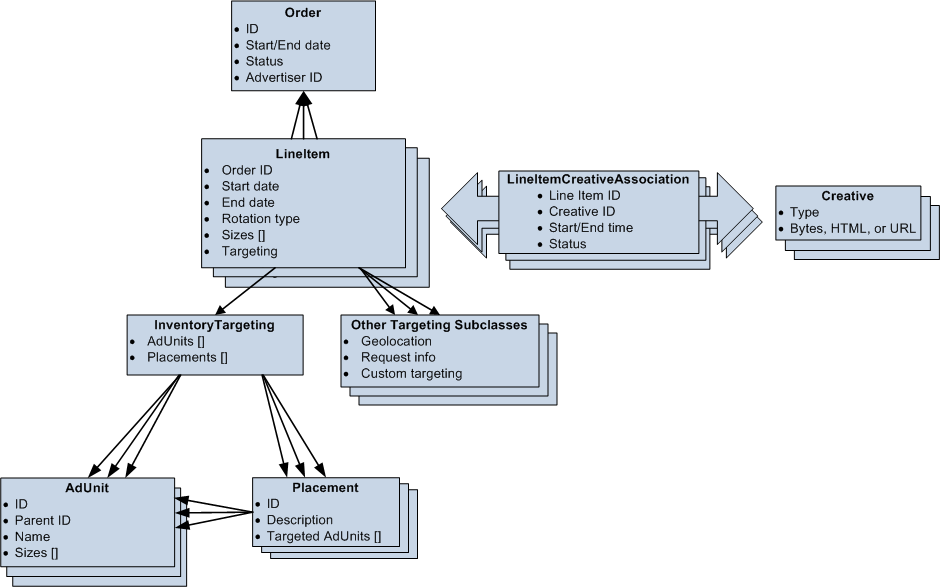Trang này cung cấp thông tin tổng quan về cấu trúc của API Google Ad Manager và mô tả các khái niệm và thuật ngữ chung trong Ad Manager.
Cấu trúc API
Dưới đây là sơ đồ đơn giản về các lớp chính trong API Ad Manager và mối liên hệ giữa các lớp đó:

Đặt
- Đối tượng
Orderchứa thông tin chung về đơn đặt hàng, chẳng hạn như đơn vị tiền tệ hoặc nhân viên bán hàng, đồng thời chứa một hoặc nhiều thực thểLineItem. Trong mã, mỗiLineItemchứa mã nhận dạng củaOrderchứa, thay vìOrderchứa danh sách đối tượngLineItem. LineItem
- Đối tượng
LineItemmô tả một tập hợp các yêu cầu để hiển thị một quảng cáo, bao gồm cách thức và thời điểm hiển thị quảng cáo, kích thước của các mẫu quảng cáo mà quảng cáo đó hiển thị và thứ tự hiển thị quảng cáo (theo thứ tự, trọng số hoặc theo hiệu suất), mức độ ưu tiên của các quảng cáo này và nhiều thuộc tính mô tả cấu trúc chi phí.LineItemcó một đối tượngInventoryTargetingmô tả những đối tượngAdUnitvàPlacementmà đối tượng đó có thể nhắm đến và các đối tượng lớp conTargetingbổ sung không bắt buộc đại diện cho tiêu chí địa lý, tuỳ chỉnh hoặc các tiêu chí khác. LineItemCreativeAssociation
LineItemCreativeAssociation(thường gọi là LICA) liên kết mộtLineItemvới mộtCreative. Bạn có thể liên kết một mục hàng với nhiều mẫu quảng cáo và cũng có thể liên kết một mẫu quảng cáo với nhiều mục hàng tùy theo loại tài khoản. Khi bạn tạoLineItemCreativeAssociation, trước tiên, Ad Manager sẽ kiểm tra xem cả mẫu quảng cáo và mục hàng có tương thích hay không; nếu kích thước khác nhau, ví dụ: bạn sẽ gặp lỗi khi cố gắng tạo hoặc cập nhật mối liên kết. Đối tượng này cũng cho phép bạn ghi đè một số giá trị trongLineItemđược liên kết, chẳng hạn như ngày bắt đầu/kết thúc hoặc kích thước (nếu bạn có mẫu quảng cáo không phù hợp với kích thước do mục hàng chỉ định, nhưng bạn sẵn sàng để Ad Manager điều chỉnh kích thước của mẫu quảng cáo cho phù hợp với đơn vị quảng cáo một cách nhanh chóng). LICA không hiển thị trong giao diện người dùng Ad Manager; đó là một quy ước API.Tệp sáng tạo
Creativeđại diện cho quảng cáo thực tế. Nếu quảng cáo do Ad Manager lưu trữ, đối tượng này sẽ chứa các byte hình ảnh thực tế, tệp flash hoặc thẻ HTML tùy chỉnh được lưu trữ trên máy chủ của Ad Manager; nếu quảng cáo được lưu trữ trên trang web của bên thứ ba, thì quảng cáo là URL hoặc đoạn mã HTML tạo yêu cầu từ máy chủ của bên thứ ba.Các lớp con Nhắm mục tiêu khoảng không quảng cáo và Nhắm mục tiêu
- Đối tượng
InventoryTargetingliệt kê những đơn vị quảng cáo liên kết với mộtLineItemcụ thể. Bạn có thể chỉ định tiêu chí nhắm mục tiêu bổ sung, không bắt buộc bằng cách sử dụng các phiên bản bổ sung của một lớp con thích hợp củaTargeting. Vị trí đặt quảng cáo
- Đối tượng
Placementlà tập hợp một hoặc nhiều đối tượngAdUnit. AdUnit
AdUnitbiểu thị vị trí quảng cáo trên một hoặc nhiều trang.AdUnitcó thể là mục tiêu của đối tượngInventoryTargetingcủaLineItemhoặc đối tượngPlacement. Đối tượngAdUnitbao gồm kích thước, mã nhận dạng và tên riêng biệt. Mã nhận dạng được dùng để xác định các đối tượngAdUnitkhác trong API; tên này được dùng làm giá trị nhận dạng duy nhất trong thẻ HTML để xác định một đối tượngAdUnitcụ thể và được gửi lại cho Ad Manager dưới dạng một phần của yêu cầu trang.

